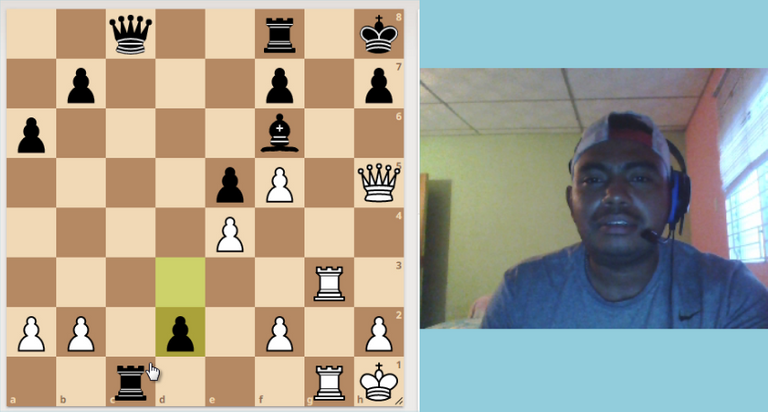[ESP/ENG] Problemas de Ajedrez, Ejercicio para el cerebro a otro nivel./ Chess Problems,.
Hola amigos bienvenidos, analizar posiciones complejas de ajedrez requiere de una preparación táctica bastante avanzada debo decir que hay problemas que son bastante fáciles de resolver Y qué sirven como ejercicio didáctico para el mejoramiento de nuestra tácticas cuando estamos aprendiendo, incluso, existe un título de gran maestro, único para aquellos que se dedican a resolver problemas de ajedrez, de los que forman parte de la historia de este deporte ciencia uno que debo Resaltar que no sólo fue campeón del mundo sino también un gran maestro en cuanto a resolver problemas se refería fue Mijaíl Botvinik, el día de hoy Les traigo las bases esenciales para resolver estos mismos comenzando con la primera exigencia la cual es el conteo de material.
Hello friends welcome, analyze complex chess positions requires a fairly advanced tactical preparation I must say that there are problems that are quite easy to solve and what serve as a didactic exercise for the improvement of our tactics when we are learning, even, there is a grandmaster title, unique for those who are dedicated to solve chess problems, One of those who are part of the history of this scientific sport, one that I must highlight that was not only world champion but also a great master in terms of solving problems was Mikhail Botvinik, today I bring you the essential bases to solve these problems starting with the first requirement which is the counting of material.

Por conteo de material me refiero a lo siguiente, cuando hablamos de problemas de ajedrez me refiero a una posición en concreto que quizás se dio en alguna partida en la vida real o sencillamente se arma la posición para que pueda resolver la idea de este modo desarrollar la profundidad de la jugada, lo primero que debemos notar al intentar resolver alguna posición de ajedrez ver y contar el material tanto de nuestro rival como el nuestro ya que es un punto importante y te dice la clara realidad de la posición, si estás en desventaja, sí está igualada o sencillamente está perdida pero, puede que haya una jugada qué puede llegar a empatar la partida o llevarte a ganarla, en este video en concreto realizo una serie de soluciones a problemas didácticos que podamos entender y lo importante de todo esto y la relación que tiene con mis videos anteriores, en muchos de los que he hecho, he hablado sobre los patrones de ajedrez y la importancia de aprendérselo. En la solución de problemas se aplica perfectamente esta teoría, te enseño además del conteo de las piezas algunos otros datos interesantes que debemos tomar en cuenta a la hora de resolver dichas posiciones, espero y disfrutes del material audiovisual, además, debo decir y advertir que las posiciones qué les muestro el día de hoy fueron en su totalidad formadas por mi persona por lo tanto al ser creada de la nada por mí no quedan registrada en ninguna página web, el tablero que utilizó pertenece chessbase, en cada posición de estudio traté tuvieran la menor cantidad de errores posibles, gracias a ese esfuerzo pude lograr cada uno de los siguientes ejemplos.
By counting material I mean the following, when we talk about chess problems I refer to a particular position that perhaps occurred in a game in real life or simply put together the position so you can solve the idea thus develop the depth of the move, the first thing to note when trying to solve any chess position see and count the material of both our opponent and ours as it is an important point and tells you the clear reality of the position, if you are at a disadvantage, if it is equal or simply is lost but, there may be a move that can tie the game or lead you to win it, in this particular video I make a series of solutions to didactic problems that we can understand and the importance of all this and the relationship it has with my previous videos, in many of which I have done, I have talked about chess patterns and the importance of learning them. In the solution of problems this theory is perfectly applied, I teach you besides the counting of the pieces some other interesting data that we must take into account when solving these positions, I hope you enjoy the audiovisual material, in addition, I must say and warn that the positions that I show you today were entirely formed by me, therefore being created from nothing by me they are not registered in any web page, the board used belongs to chessbase, in each position of study I tried to have the least amount of errors possible, thanks to that effort I could achieve each of the following examples.
El tablero utilizado para la demostración es del software Chessbase15 y todos los derechos de autor pertenecen a la compañía Chessbase. Solo anoté las jugadas y las explico en este tablero.
The board used for the demonstration is from the software Chessbase15 and all copyrights belong to the company Chessbase. I only annotated the moves and explain them on this board.
Las imágenes son capturas de pantalla en el desarrollo de la partida.
The images are screenshots during the development of the game.

▶️ 3Speak